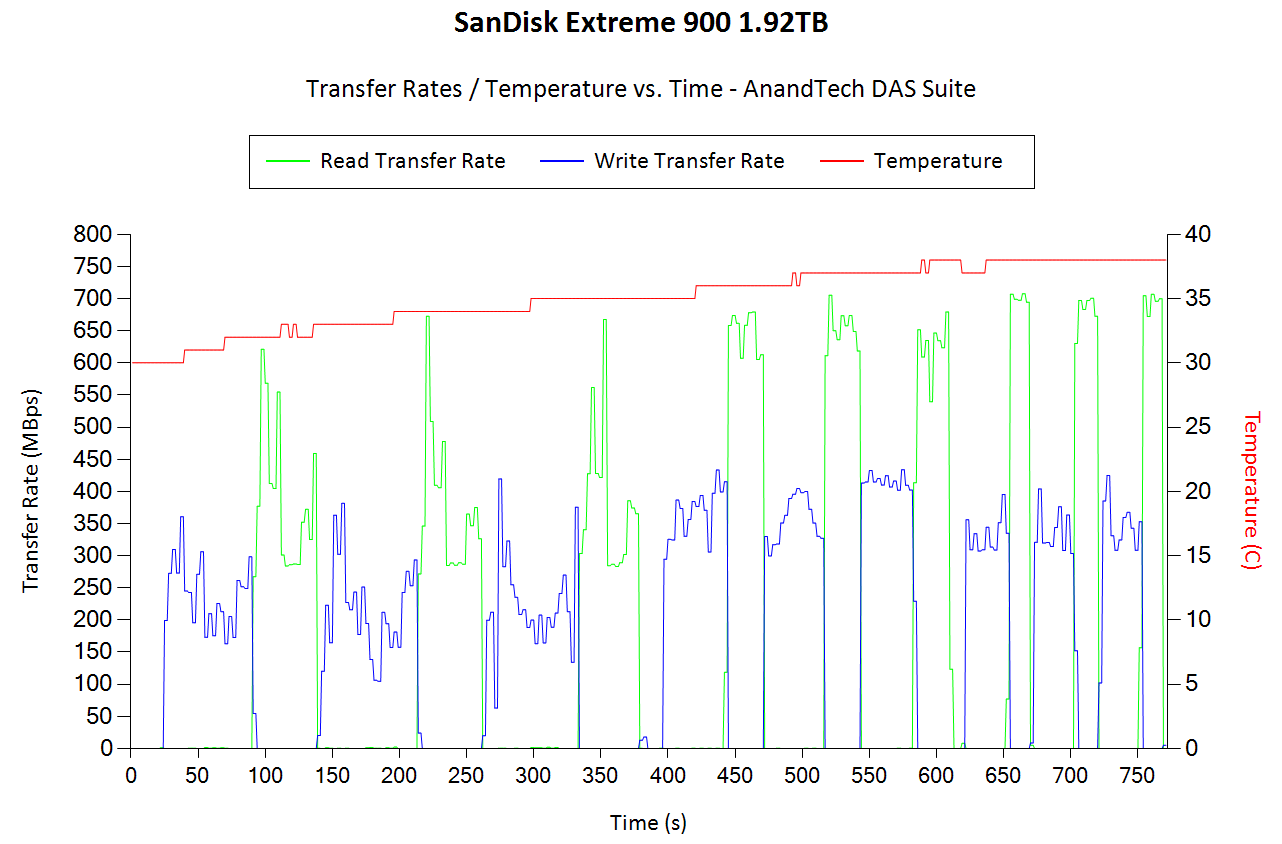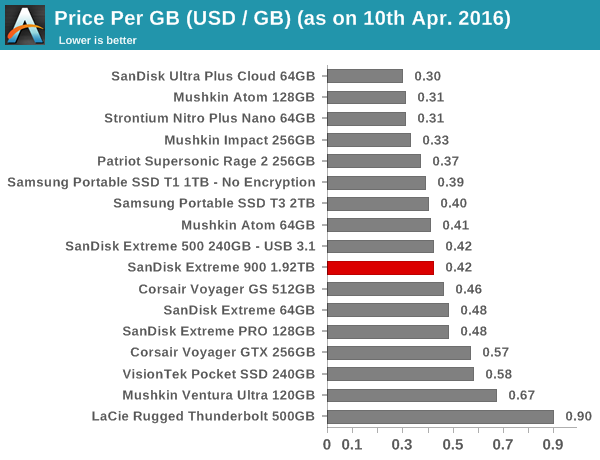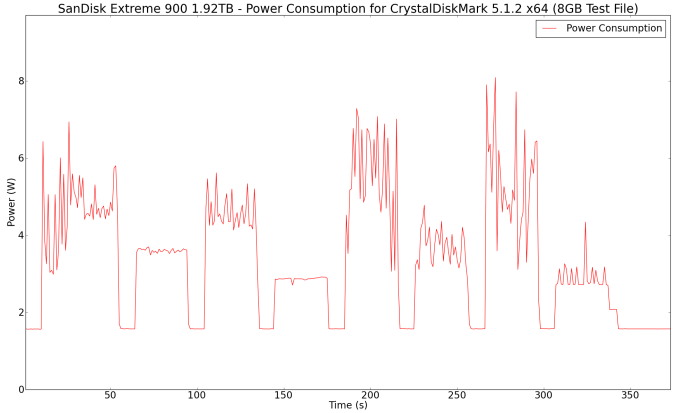SanDisk Extreme 900 USB 3.1 Gen 2 Portable SSD Review
by Ganesh T S on April 11, 2016 8:00 AM ESTPerformance Consistency
Performance consistency is an interesting aspect of flash-based storage devices. Aspects that may influence this include thermal throttling and firmware caps on access rates to avoid overheating or other similar scenarios. This aspect is an important one, as the last thing that users want to see when copying over, say, 100 GB of data to the flash drive, is the transfer rate going to USB 2.0 speeds. In order to identify whether the drive under test suffers from this problem, we instrumented our robocopy DAS benchmark suite to record the flash drive's read and write transfer rates while the robocopy process took place in the background. For supported drives, we also recorded the internal temperature of the drive during the process. The graphs below show the speeds observed during our real-world DAS suite processing. The first three sets of writes and reads correspond to the photos suite. A small gap (for the transfer of the videos suite from the primary drive to the RAM drive) is followed by three sets for the next data set. Another small RAM-drive transfer gap is followed by three sets for the Blu-ray folder.
An important point to note here is that each of the first three blue and green areas correspond to 15.6 GB of writes and reads respectively. Throttling, if any, is apparent within the processing of the photos suite itself.

Reads of large-sized files is not an issue at all, with transfer rates staying well above what is possible with a USB 3.0 interface. The main problem is the transfer of a large number of small-sized files (as in, photographs with sizes between 4 and 8MB). Depending on the state of the SLC / TLC cache, the completion of the writes (and, in turn, the write speeds) can vary quite a bit. As one can see from the second and third set of 'photo writes, the difference from run to run can be as much as 50 MBps. That said, the speeds are quite satisfactory overall.
Power Consumption
The power consumed by the SanDisk Extreme 900 1.92TB was measured under multiple scenarios. These scenarios were triggered using CrystalDiskMark 5.1.2 x64 with a 8GB test file and each test separated by a 10s interval. The initial part of the graphs below show the idle power consumption of the drive. This is followed by the power consumed when CrystalDiskMark prepares the 8GB test file on the drive. The eight distinct segments that follow show the power consumption profile for the workloads (single-threaded sequential and random accesses with a queue depth of 32, followed by sequential and random accesses with a queue depth of 1). The first four segments correspond to read accesses and the last four to write accesses.
The drive pulls around 1.57W from the host at idle. Write accesses are more power hungry, with a peak power consumption of around 8.1W. SanDisk suggests using USB ports capable of delivering up to 10W of power for optimal performance. It is obvious that using a port capable of delivering only the usual 5W will heavily hamper the performance of the unit.
Concluding Remarks
Coming to the business end of the review, the Extreme 900 shows that SanDisk is not unwilling to take a risk by developing products for a market still in its infancy. While USB 3.1 Gen 2 has been around for more than a year now, there have been no mass-market devices taking full advantage of the interface yet. The Extreme 900 is one of the first bus-powered USB 3.1 Gen 2 client devices available for general purchase.
The performance and capacity of the drive leaves us with no doubt that it would be great for quickly transferring large-sized multimedia files. The bus-powered nature ensures that it can be easily used in the field, away from AC power sources. Minor points of concern include the usage of TLC flash (leading to endurance concerns) and the inability to recognize and take actions on the drive based on S.M.A.R.T features such as TRIM.

Despite being one of the first USB 3.1 Gen 2 client devices in the market, the unit is quite reasonable priced in terms of price per GB. The SanDisk Extreme 900 1.92TB is currently available on Amazon for $800. The 2TB Samsung Portable SSD T3 is also currently priced at $800. It gives the user an extra 80GB, leading to a slight price per GB advantage for the Portable SSD T3.
Hardware encryption capabilities and the form factor aspect also favor the Portable SSD T3. However, the Extreme 900 performs better in most real-world benchmarks and also comes with the more recent USB 3.1 Gen 2 interface. SanDisk deserves praise for bringing a unique product to the market.












31 Comments
View All Comments
MattMe - Tuesday, April 12, 2016 - link
The comment about being normal was written tongue firmly in cheek.pav1 - Tuesday, April 12, 2016 - link
Normal people don't post on forums.Ratman6161 - Monday, April 11, 2016 - link
Both SanDisk and Samsung have smaller capacity, lower priced versions of their drives that would be of interest. For example on Amazon SanDisk has a 960GB version for $500 which sounds like just 1 960 GB instead of two in RAID 0 (which may also solve the issue of no trim if its a single drive rather than RAID 0???). Samsung has: 250 GB T3 for $129, 500 for $197 and 1 TB for $427. The 500 GB actually seems pretty reasonable to me as its big enough to fit several VM's of the size I'd use it for and the price is still relatively low.ganeshts - Monday, April 11, 2016 - link
The 960GB version of the Extreme 900 is 2x 480GB in RAID-0jameskatt - Saturday, May 7, 2016 - link
The Mushkin Enhanced Reactor TC 2.5" 2 TB SATA III MLC Internal Solid State Drive (SSD) MKNSSDRE2TB-TC from Amazon costs $500. Place this in a thin $20 USB 3.0 enclosure. You'll save $300 over the SanDisk and Samsung external 2TB SSDs.zepi - Monday, April 11, 2016 - link
Sounds like a decent way of increasing the iops/storage when running a bunch of virtual machines on a laptop or even a desktop machine and taking them with you whereever you go.Not free for sure, but compared to the price of internal storage options and impossibility of even having 2TB in most laptops, this is not bad.
BrokenCrayons - Monday, April 11, 2016 - link
External storage for a virtual machines seems like a good use case for the Extreme 900. I can't think of too many others that would justify the fairly steep MSRP vs storage capacity that can readily benefit from the added performance.ImSpartacus - Monday, April 11, 2016 - link
It's sad that we have to say, "usb 3.1 gen2" now...Flunk - Monday, April 11, 2016 - link
USB 3.1 Gen 1 is such a scam.Gunbuster - Monday, April 11, 2016 - link
I would have thought $800 would afford you a enclosure design slightly more exciting than what can be had on amazon or eBay for $10